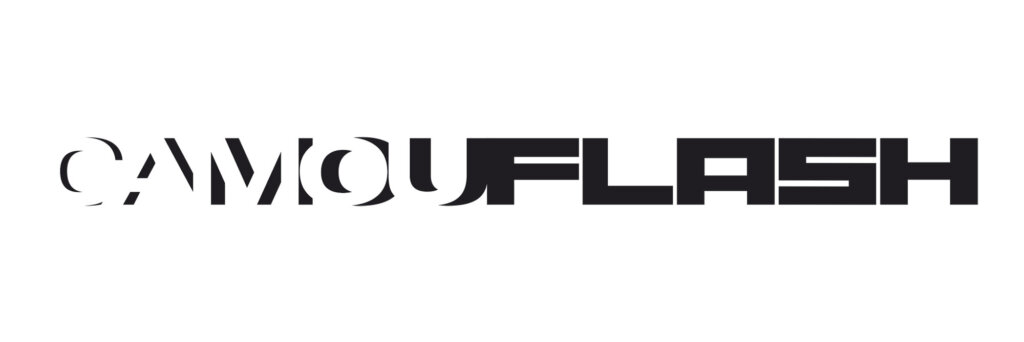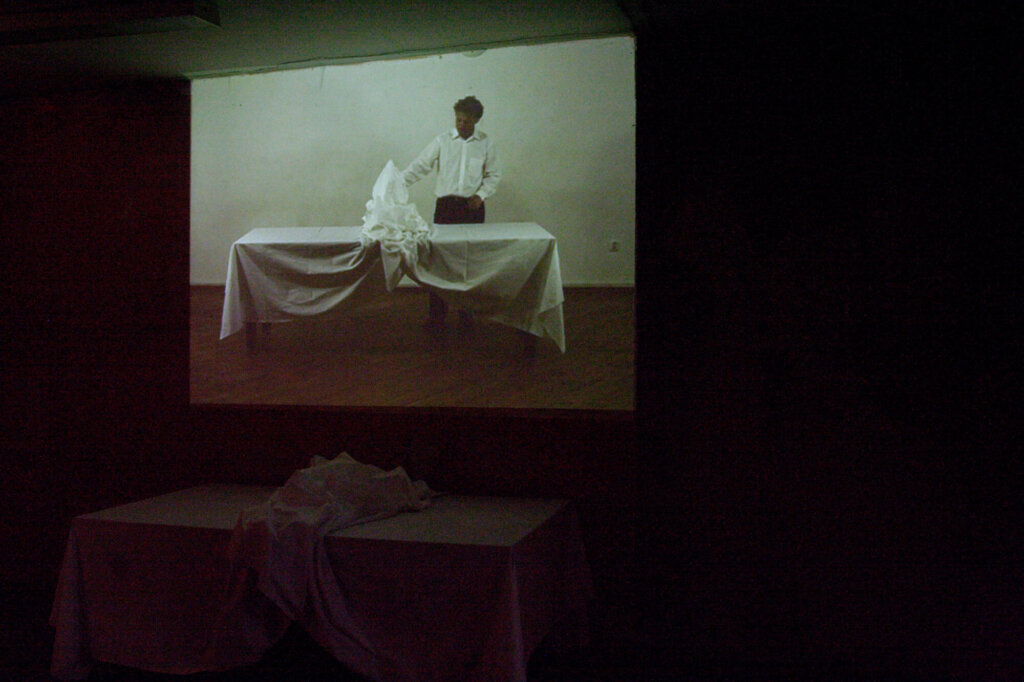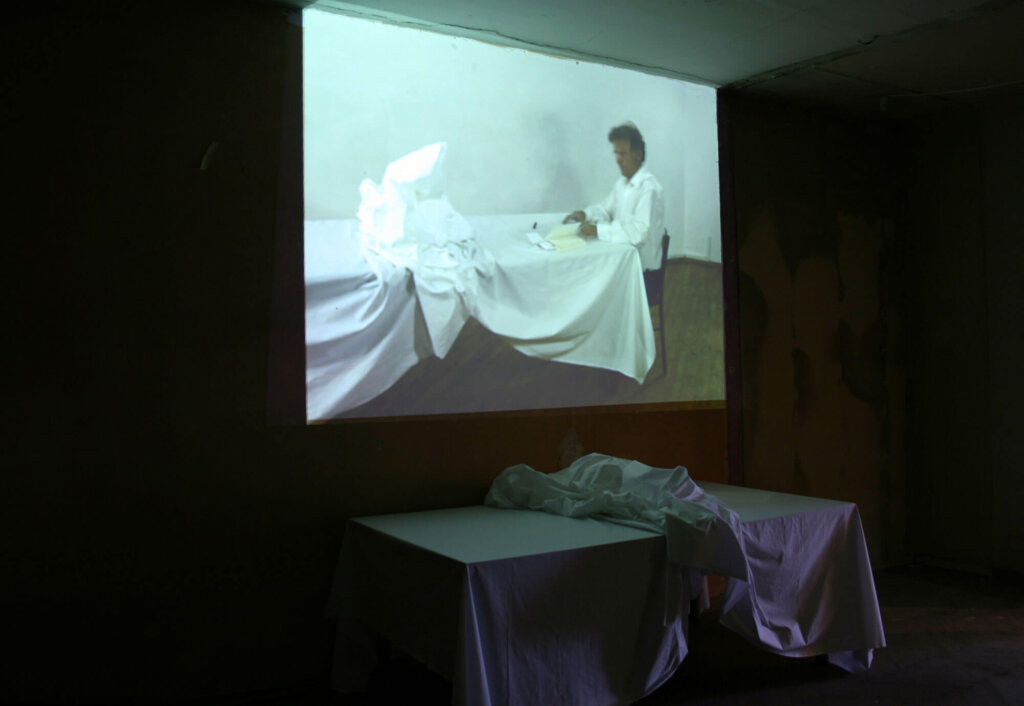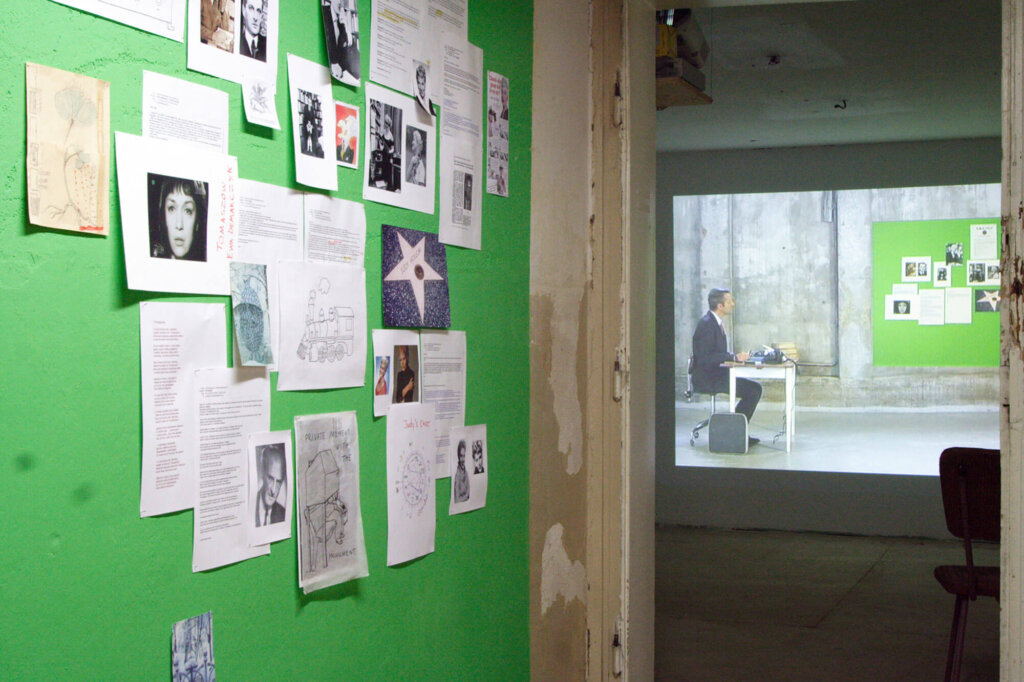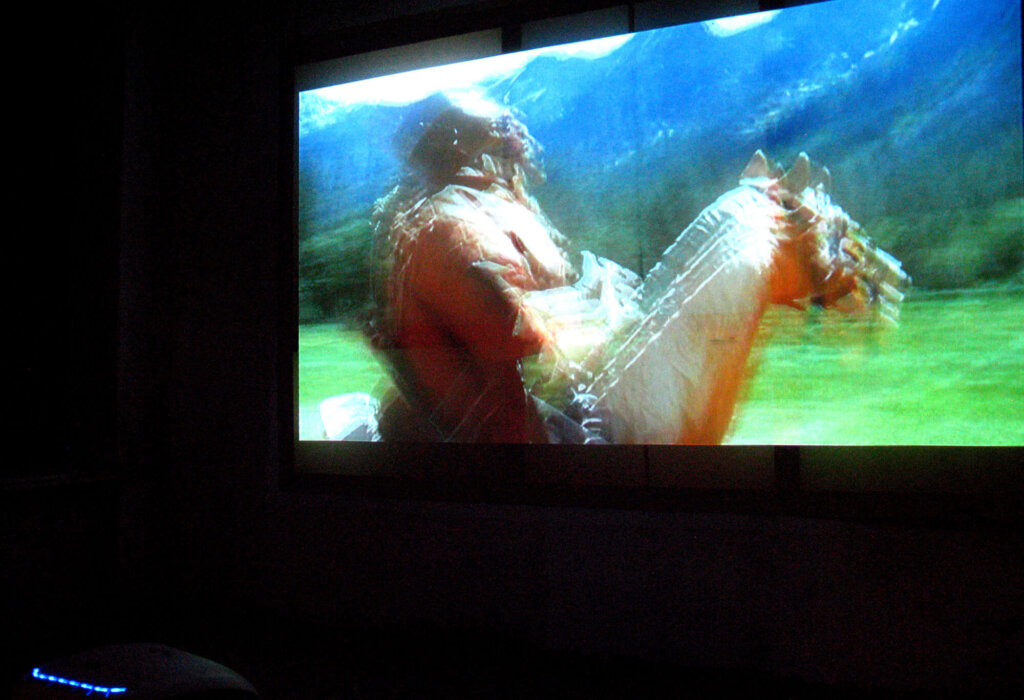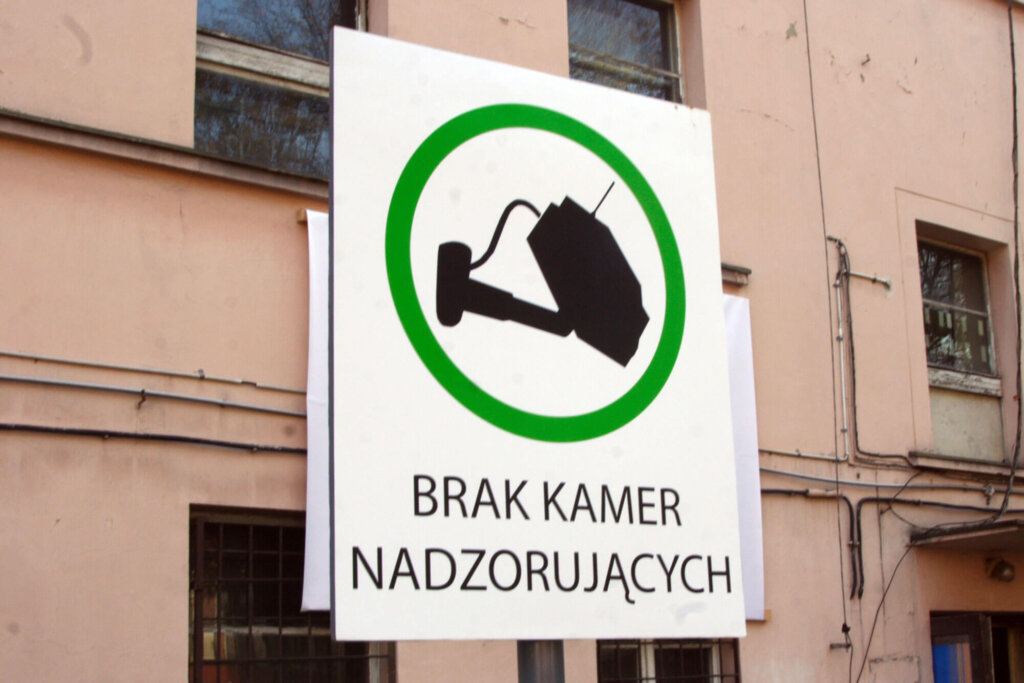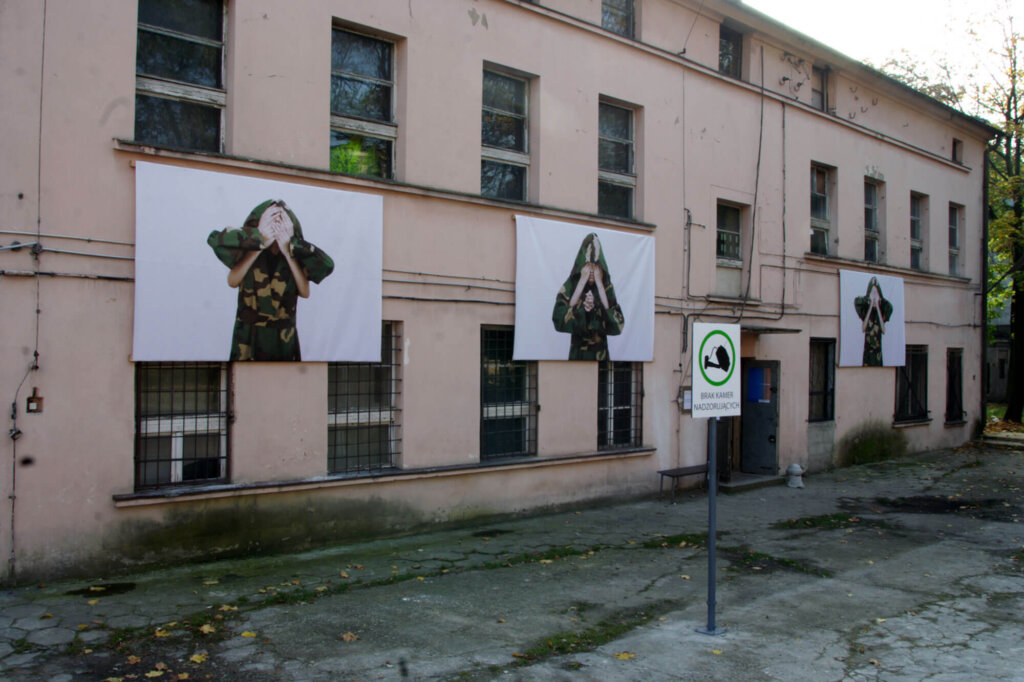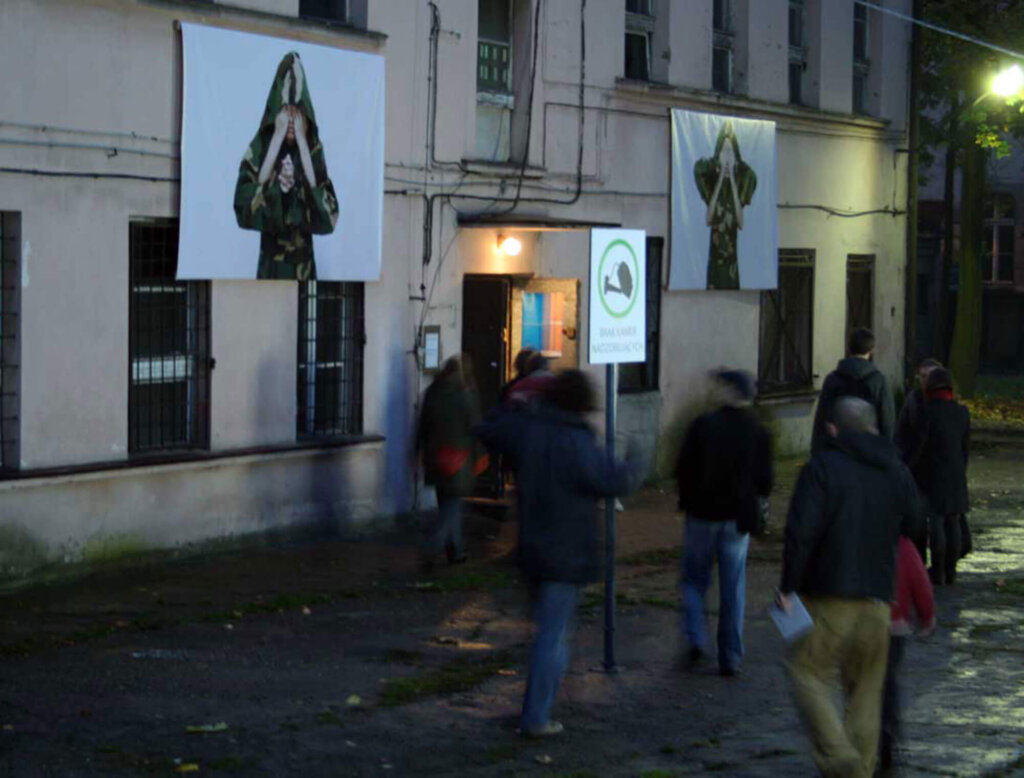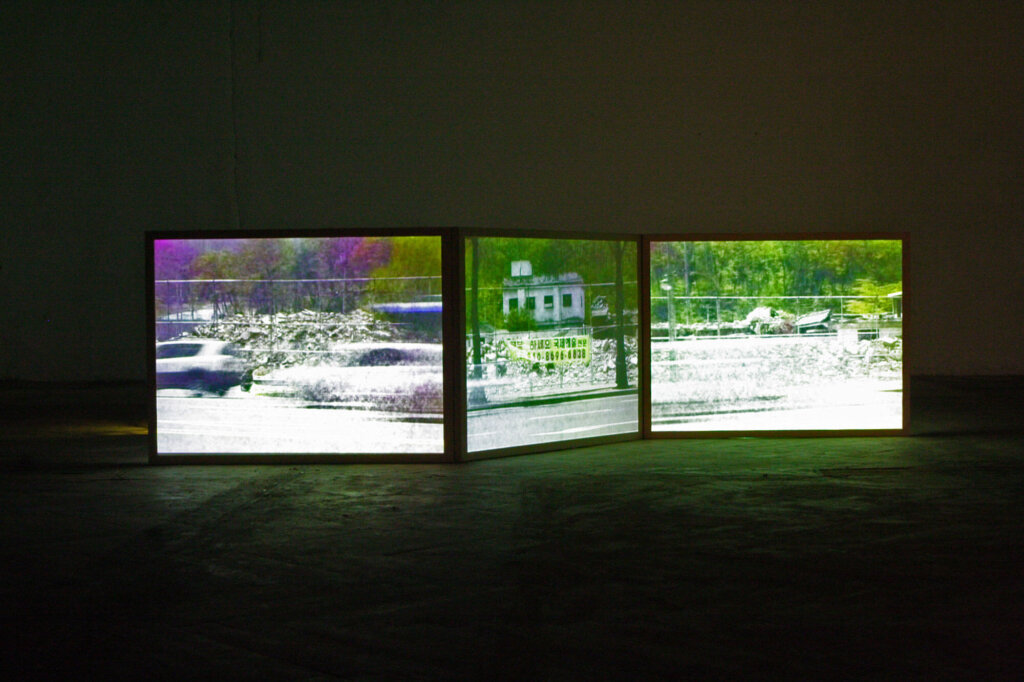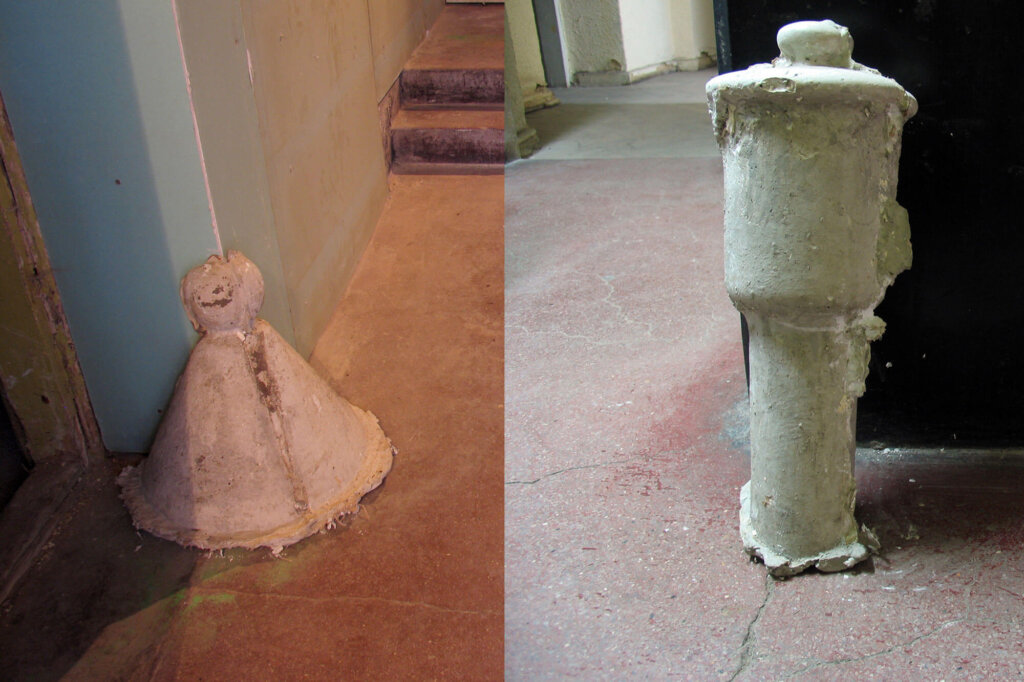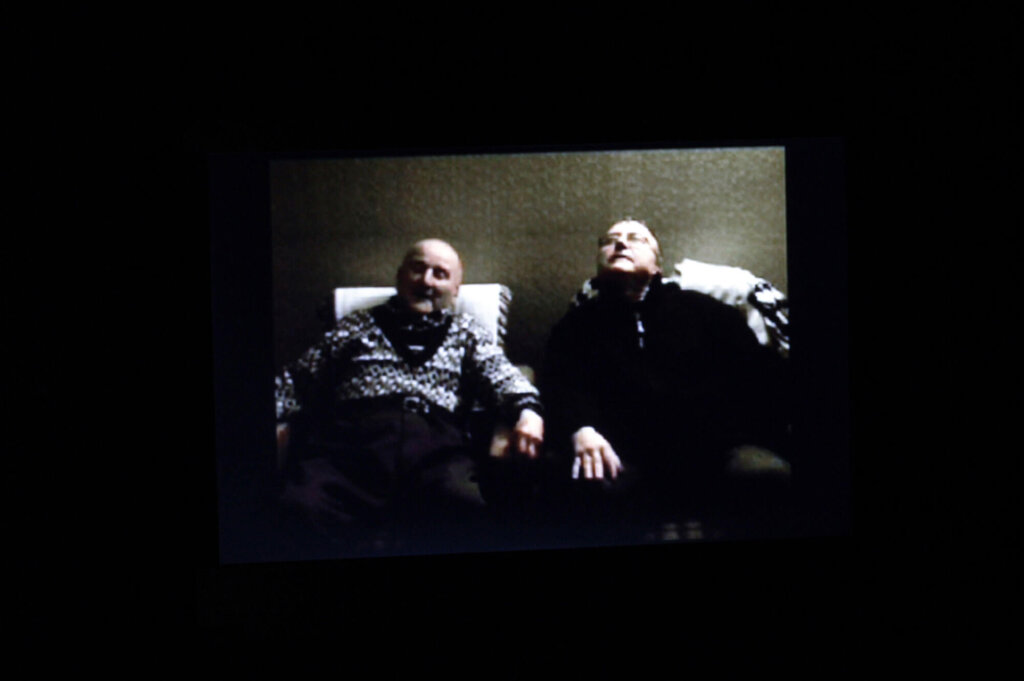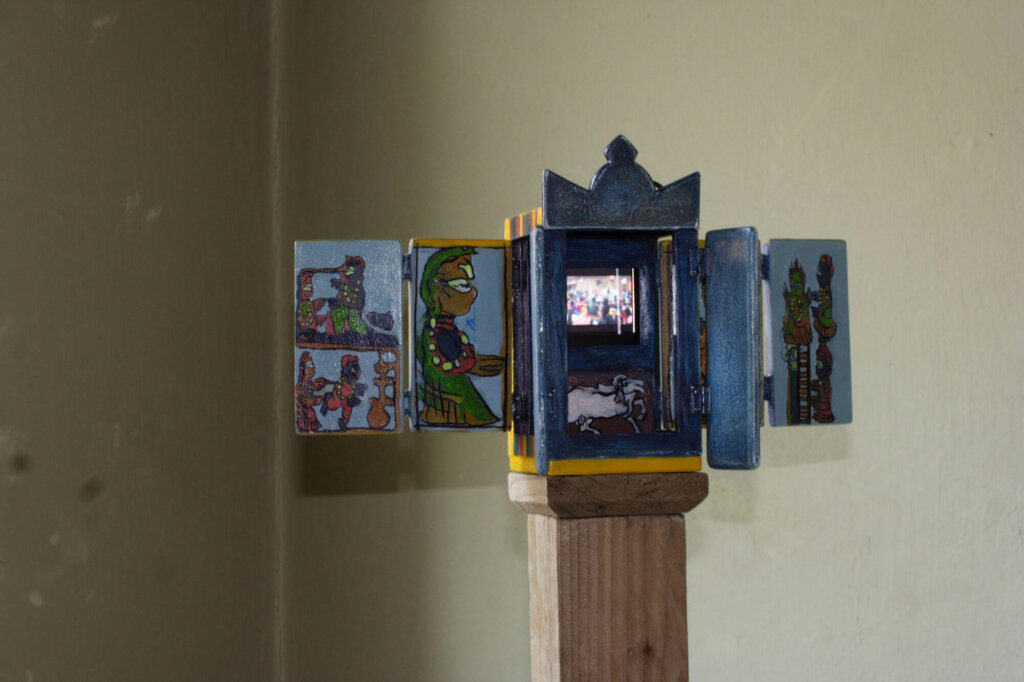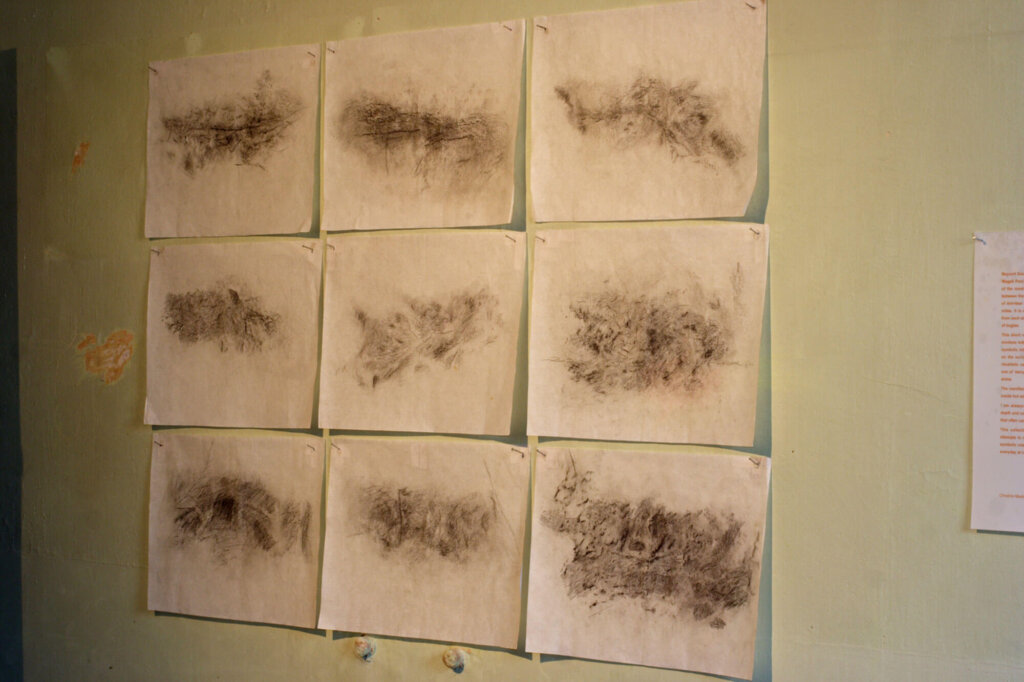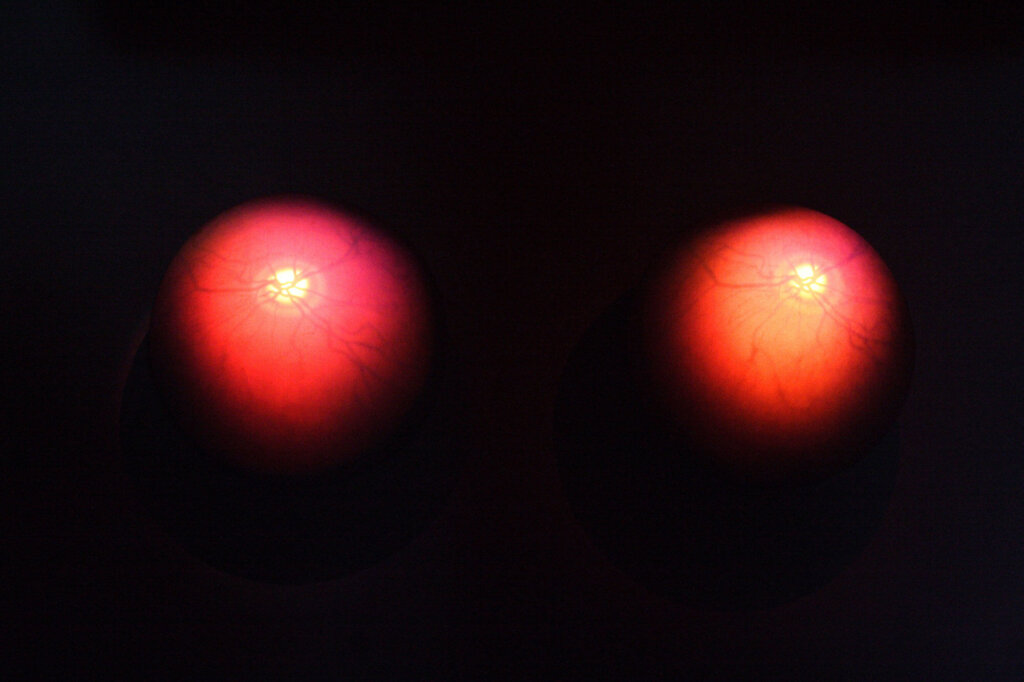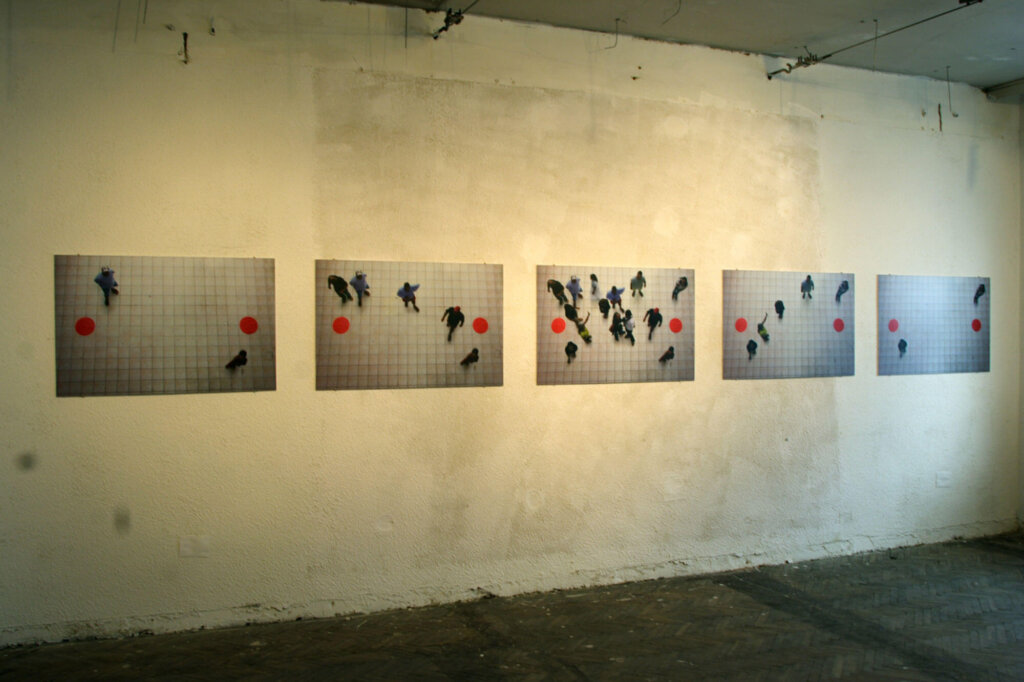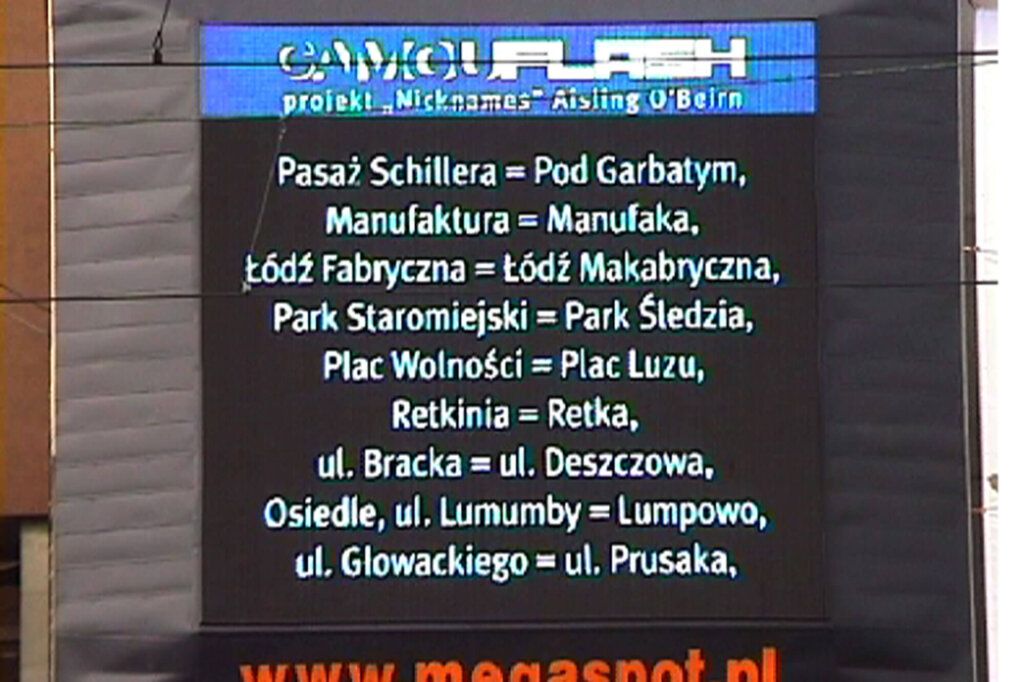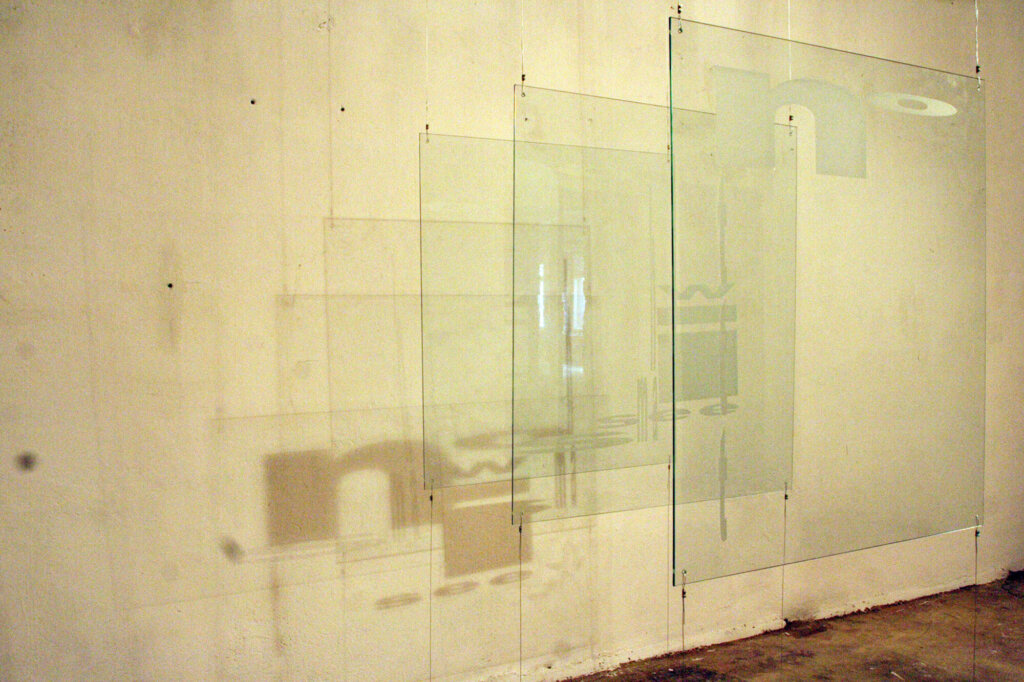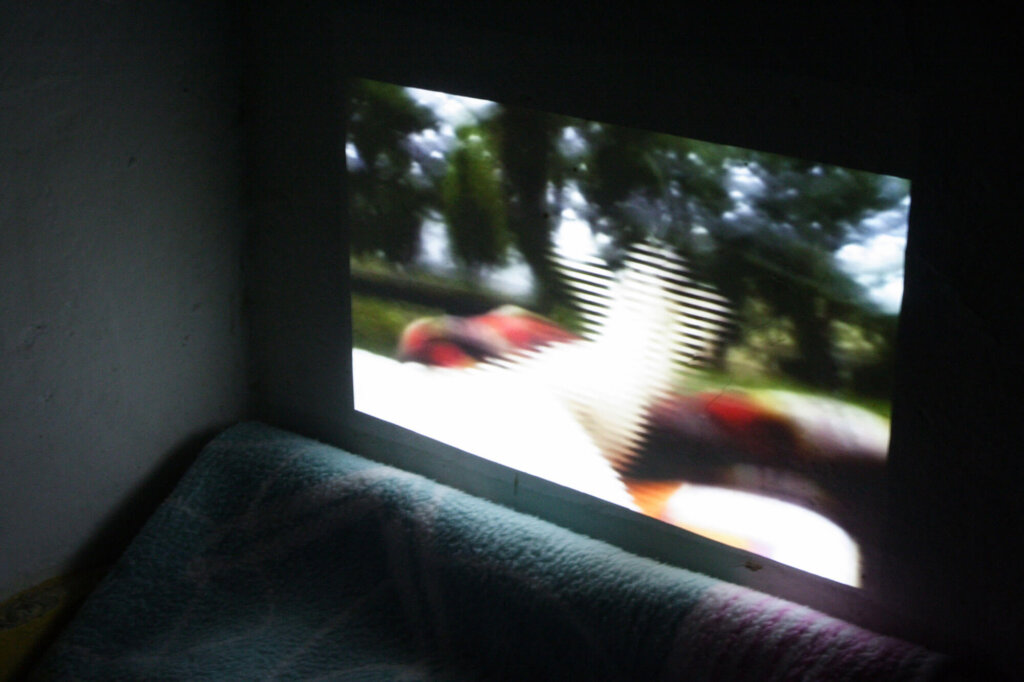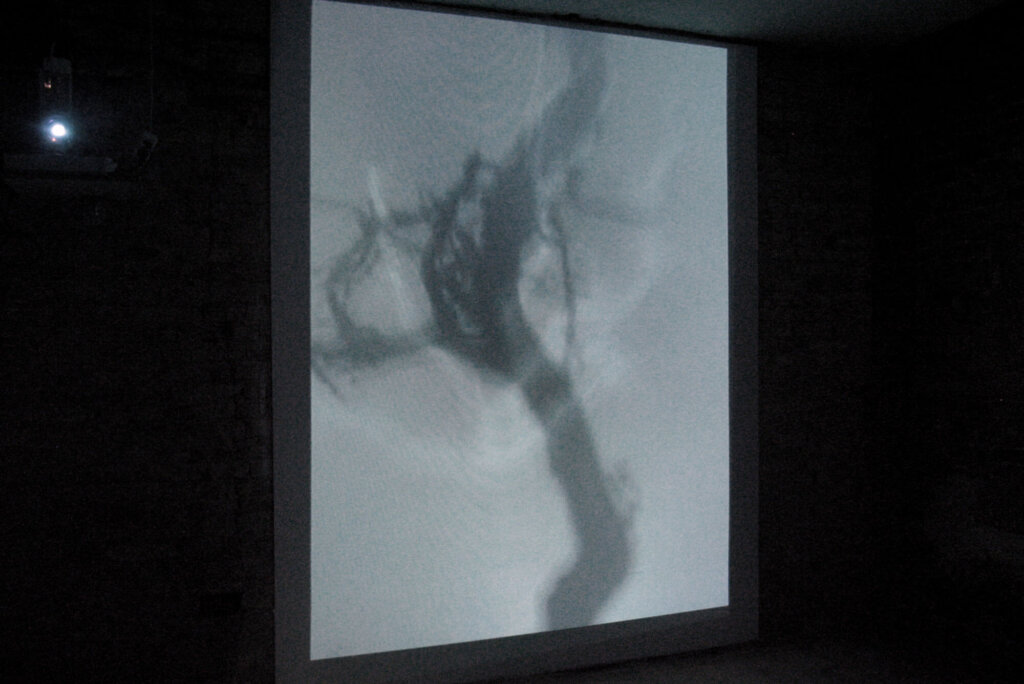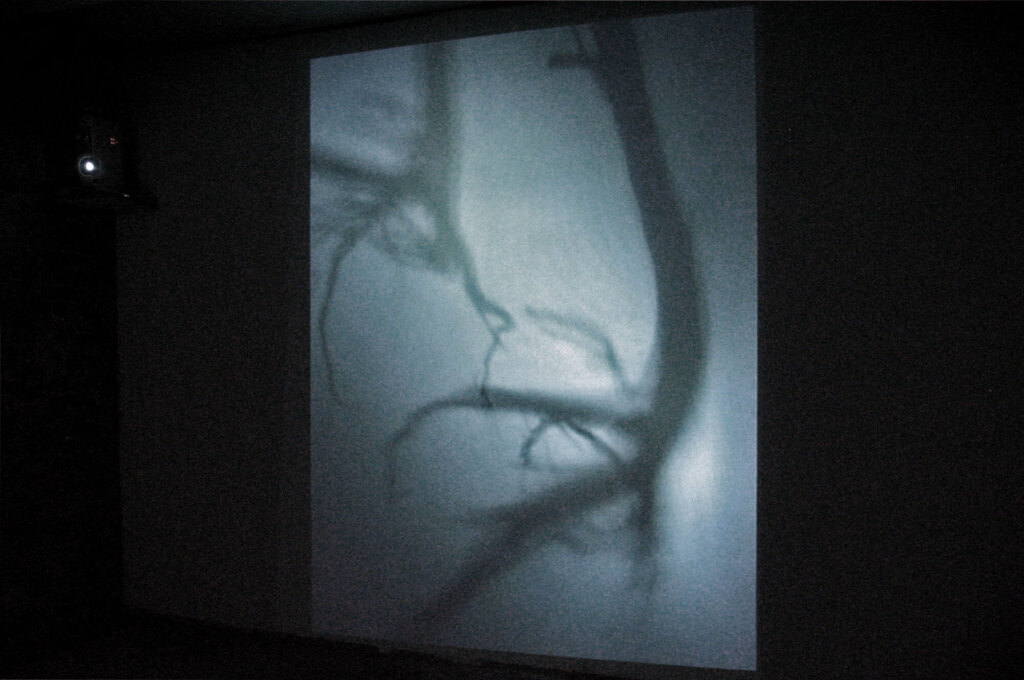”CamouFLASH”
artistic project / events. The idea of ”Camouflash”: Mariusz Sołtysik.
First event took place in Łódź, in EBRO building, Poland in 2007;
curators: Mariusz Sołtysik, Aurelia Mandziuk-Zajączkowska
link to relation of Erika Kneer on the web page of Artist Organized Art NY
Camouflash – is a free combination of the word camouflage, which means concealment, disguise, and the word flash which means a spark, moment, short message. The combination of these two words determines the subject of the exhibition, which is the condition of the contemporary man in the context of camouflaging oneself, and concurrently wishing to become known, to shine. This specific schizophrenia is by no means marginal, as proved, e.g. by the various reality shows, some of which attract artists, too.
The contemporary culture is rather pictorial in nature, idea has been marginalised. The plethora of pictures in our lives induces a sense of being lost, or immunises us against them by creating and augmenting trite reception of such pictures, which, consequently, makes them neutral (e.g. another murder). Obviously, such trite and superficial reception is also true of religion, art and its products.
On the other hand, noticeable social behaviours indicate an urge to appear in the media in a short flash of an advertisement or reality show. This urge replaces the essential question: “what idea do I want to pass across?” or “what is my principal message?” People appear to participate in the social and cultural life, but on the level of entertainment, rather than inclusion or reflection on human existence. The present-day society seems to be complex, however, following the thought of Jean Baudrillard, it is rather a mass that is “an opaque nebula whose growing density absorbs all the surrounding energy (…), to collapse finally under its own weight. A black hole which engulfs the social.”
Before the black whole is formed, however, there is a short, yet spectacular explosion, followed by a collapse of a massive star. Relating this to human behaviours, perhaps this flash is the one and only opportunity to step out of obscurity before disappearing and being absorbed by the mass? To what extent, then, is this flash true and is not a camouflage, a desire to be somebody else for a moment?
It seems that just to induce the question “who am I and what am I doing?” is in itself a great success.
Mariusz Sołtysik
Artist’s texts about ”CamouFLASH”:
Camouflash is a hybrid word, which, through a linguistic manipulation, opens a game of opposites. The emerged word of contradictory meanings holds a disguised, hidden nature, but also a flash of an exposition, a flash of a performance and a single act of fulfillment.
Camouflash is an attempt to build a structure which enables us to conceal something in broad daylight and to disclose something in the darkness. The contrast of the conflicting values seems to be domineering, but it is the act of finding an accurate exposition mechanism, constructed in such a way that the concealment of a fraction of the message is innate, that is truly crucial.
A piece of paper set on fire in the darkness allows the reading of the message as long as the process of destruction lasts. Reading the message becomes a single and unrepeatable act.
Employing the fire and the word destruction introduces a redundant pathos, but that is insignificant. The act of exposition contains an unconditional, irreversible concealment and that is the true camouflash.
Janusz Bałdyga
—
Guilt by association is a well-established concept and more recently the phenomena of celebrity by association has become very prominent as well.
In preparation for the Camouflash project in Lodz I am researching a couple of personalities that in very different ways were and still are to some extent big celebrities. One of them is the poet Julian Tuwim from Lodz and the other is Oscar winning actress Judy Holliday (Judith Tuwim). Both of them are my distant relatives and I am interested in juxtaposing our dissimilar worlds by mapping a link through time and space…
Olga Bergman
—
Im my photo series, Joe Goes Around the World and in the videos, Joe Goes to India and Yosemite Joe, I wanted to replay with my childhood puppet on the world stage. As a popular icon Joe personifies a reversal of himself by both revealing and camouflaging his identity within the context of the cultures he participates in. The interactive performance and the spontaneity of his contact with people, places and landscapes creates dialogue and interaction,which makes visible the intercultural situation,emphasizing real people and locations in the background,while exposing through juxta-opposition his surreal artificiality as image and identity. In this sense Joe satirizes the meaning of his persona as a media stereotype while communicating as a popularized icon.In Joe Goes to India,the video is unedited to emphasize the immediacy of the situation and its absurd representation .In Yosemite Joe, he gallops on his horse aimlessly in circles in Yosemite Valley, a popular tourst site which panoramically displays the grandeur of the American West. For Camouflash I felt that these two videos critique Joes ambiguous identity as image, performance and narrative,in contrast to the way media creates staged meaning for the viewer.
Charlie Citron
—
Poem song
A scroll is laid on the floor.
A person quickly rolls up into it, sounds of crinkling paper emerge
The person moves with the score
Another person holds one end as the person slowly unfurls, unwinds
A composer begins to play the structure, interpreting the score
A person quickly flashes a brush with ink, and splashes the form, poetry is heard from a distance
When the person has reached the end of the scroll, both people show the audience, and hang the score on the wall
Jessica Higgins
—
My response to the Camouflash has been inspired by the famous words of Gandhi which read – Do not hear, do not speak, do not talk. In the contemporary world, it may seem convenient to choose not to engage and therefore not to have to act. Countless examples of the above attitude come to mind. By showing my series of photographs,
I hope to encourage the viewers to reflect creatively on the meaning of the words of Gandhi.
Shilpa Gupta
—
for Camouflash:
A series of abandoned advertising banners have been rephrased, large parts of the original text have been painted over in white, and new letters have been superimposed on them. Thus, for example, the original slogan: “International Marriage – Vietnam / Cambodia – Specialist” has been replased by “International Art – Be Happy – Specialist”
Gabriele Horndasch
—
Metagram series
Metragram on a Kashubian woman
village of Łątcziński Hëta, Kashubia region, Pomerania voivodeship
(Republic of Poland/2007)
Metragram on an Arab woman
neighborhood of Zamalek, Gezira Island, Cairo
(Egypt/2006)
Metragram on a Silesian woman
Pomnik Powstańców Śląskich, Katowice, Silesian Voivodeship
(Republic of Poland/2007)
Metragram on a Tagalog woman
18th avenue, Quezon City,
Eric Van Hove
—
The video “severance” (20 mins) was shot in 2004 in Tasmania Australia during the burning season, when the loggers burn all the forest they have cleared during summer. The video was made for an environment group “The Wilderness Society” which is trying to stop the insane destruction of the largest remnant temperate rainforest in the world, the Tarkine Wilderness area. Tasmania is the last place left in the developed world which is still engaged in large scale industrial logging of its old growth heritage. Some of these areas are irreplaceable and contain trees thousands of years old and many endangered species
I travelled into the forest and saw the primal beauty, the funghi, the pristine rivers, the ancient and massive trees big enough to build a house; then I flew over the area and saw the scale of destruction from the air. I saw the destruction of creation.
For me the experience was both stunningly beautiful and horrifying; it was a camouflash in that the harmonious integration of the complex natural ecology was periodically shattered by coming across shocking examples of destruction: human instigated ecocide.”
Richard Thomas
—
Camouflage = Subject = Self
Flash = Object = What we are perceiving.
My interest and response to the combination of these two words as the subject of the exhibition “Camouflash” is how it relates to concepts of Buddhist meditation practice, more specifically the Shambhala teachings, or Sacred Path of the Warrior, brought to the west by Chogyam Tungpa and it’s capacity to heal the condition of contemporary man by creating an enlightened society. The self has a natural tendency to cocoon, conceal or camouflage itself. The driving energy behind this is fear. The object is to experience the world without camouflage. The vast majority of life is moved through unconsciously, so the “flash” is that moment when one is fully awake in the present moment. This is a state of fearlessness, groundlessness as well as of rawness, vulnerability and tenderness. For me “this specific schizophrenia” of conflicting emotion is about the ability to move through the habitual social patterns of surface entertainment and embrace who you are completely with gentleness, fearlessness and Intelligence. Mindfulness meditation practice is in essence one way to create this kind space around the mind. …”perhaps this flash is the one and only opportunity to step out of obscurity before disappearing and being absorbed by the mass? To what extent, then, is this flash true and is not a camouflage… — Mariusz Sołtysik”
Erika Kneer
—
Beyond Sounding(s) – (mobile shrine)
The research field ‘Narrative psychology’ explores how stories work rather than the focus on the meaning the story conveys. This process extends the traditional function of the story from one of ‘story-telling’ to the experience of event(s) embedded in the story to a broad cultural areana. Therefore the relationship between ‘agency’ and ‘action’ and the manifestation of the narrative is defined not only by what happens inside but also how it relates to outside of the frame, by what Foucault calls ‘discursive formations’. Beyond Soundings – (mobile shrine) is a ‘tourist’ record of an event at Wagah Post, a road crossing that divides India and Pakistan. This is one of the most-watched, high-security border zones in the world. It falls between the historical city of Lahore in Pakistan and the Sikh holy town of Amritsar in India. The distance between the two cities is a mere 35 miles. It is a ceremonial border, where, each evening, armed soldiers from each side of the border enact a particularly hostile parade while lowering their respective flags to the sounding of bugles. This short video-work is contained within a re-construction of a miniture Indian shrine. The symbolic interaction between the ancient mythological story composed on the surface of the shrine and the constitutive power of this daily ritualistic contemporary ceremony is presented as a process of ‘collective functioning for which narratives are paradigmatic’ (Propp). Rethinking Psychology: Volume 1 – Conceptual Foundations (ed J. Smith, R. Harré, & Luk van Langenhove) Sage, 1995.
Christine Mackey
—
Affluenza clogs our social and individual arteries.
Affluenza ( n.) ( aff.loo.en.zuh) is a term coined to describe a growing societal illness. Particularly associated with the west, this disease is an extreme form of materialism in which consumers overwork in order to accumulate more goods… the premise being that more brings more contentment. This tendency leads to a ‘hedonic treadmill’ (n), economic desires rising at the same rate of income resulting in no net gain of satisfaction or happiness. Daniel Kahneman.
The FLASH referred to in camouflash speaks to me of a short lived desire to fill the void once occupied by certainty. Into this framework I place (my) faith in an interpersonal system of empathetic exchange.
Anna Macleod
—
Camouflash, as a combination of words, might be seemingly contradictory.
“Camouflage” on one hand, that is something masking, hiding from our view, seems to appear as a meta-space between the real quality of an object, its realness, and our aspiration to study it, to get knowledge of it. “Flash”, on the other hand, as a light strike, sudden enlightening of that meta-space that appears for a split second to unveil a barrier or boundary preventing us from entire knowledge.
Mask does not fall utterly though, it just appears, reveals itself for a very short period of time. This fact is valuable itself, although does not lead us to our aim all along, but surely positions us closer to it.
I might compare the camouflage as a process to the will of learning by naming, putting terms or even definitions onto the objects. From the communication point of view this is useful, from the knowledge point of view it is just another form of interpretation.
The art is capable to call such a “flash”, a sudden disclosure of “camouflage – interpretation”, and an attempt to detect what hides behind.
Mariusz Olszewski
—
For the Camouflash Project in Lodz I propose gathering as many place nicknames from around the city as possible and then exhibiting or publishing them in a public, perhaps official looking format or context. By nicknames I mean unofficial place names that people use commonly for places, streets or local landmarks, but which do not appear on city street maps or other official, formal state or city documents.
This idea is concerned with contemporary, unofficial information about urban places. I work with this type of information, as I believe it reveals much about the politics of place, and how people describe their locality and use local knowledge to navigate the urban environment. I am also interested in taking on the challenge of making a site-specific work for Lodz, without ever having been there and despite the fact that I cannot go over for the project. This project becomes a possibility to ask questions and get local vernacular information about Lodz, a city I have never visited.
Aisling O’Beirn
—
Skilful concealment by means of disguise; mimicry; behaviour or artifice designed to deceive or hide.
Camouflage – the disguising especially of military equipment or installations; covering; masking sth.
Etymology: French, from camoufler to disguise.
The title of the Camouflash exhibition undoubtedly refers to the word camouflage, which dictionary definitions I cite above.
The word, which is normally associated with the world of animals and the military, enters the realms of art. Moreover, it is heavily grounded in the field of sociology, where the methods and means of concealment and mimicry may embody more subtle, if not invisible at first sight, forms. It seems to be indispensable here to mention the act of wearing social masks to become present in public, to be socially accepted, liked or admired. This act of concealment, of course, pertains to all human relations.
FLASH is understood here as a certain temporality, and persistent changes forcing themselves with an extreme speed on our reality. It also refers to the constant need to adapt and adjust induced on us by those changes. It is worth noting here that these phenomena seem to be characteristic features of the turn of the 20th century.
Tomasz Matuszak
—
Camou is a desire to merge and connect with our environment and with each other. In a Flash we see our differentiation, uniqueness, our desire to shine and the temporality of our life span. We have a simultaneous desire for rootedness and a desire for transcendence.
Groundless Earth works with the shadows of roots. As in CamouFlash, there is a tension film between what is concealed and what is revealed. Strong light, spot lights, creates shadows, a distinction between things. The roots appear by being both hidden and made visible through illumination. The work is calligraphic, the gesture and shadows of the roots somewhat hypnotic. The focus is not on the object but on the gesture that it radiates.
Suzy Sureck
—
Average woman
In my camouflash, I have decided to include a Polish female element. Average woman is a mother first. It is not new; it has been like that for thousands of years. Giving birth – the simplest, the most primitive and unquestionable way to identify own identity. It is also a way of providing a justification for your own existence and a way to satisfy the need to do something important which may be, at the same time, a camouflage and a flash.
Ewa Szczyrek-Potocka
—
I think the idea of Camouflash is people lives in a daily life but somewhere wants to run away from it or to be another person ( for example a movie star or some famous person) in deep mind. I think travelling is good way for relaxing or escaping from the daily life in a short term but we need home after travelling, otherwise we will wander and walk in life. I will make a project of “RUN WAY in Lodz” for the Camouflash. Runway means a way for an air-plain. My project is to make a temporary runway when I travel. It appears a light way in an hour or so on a street.
Miyuki Yokomizo
